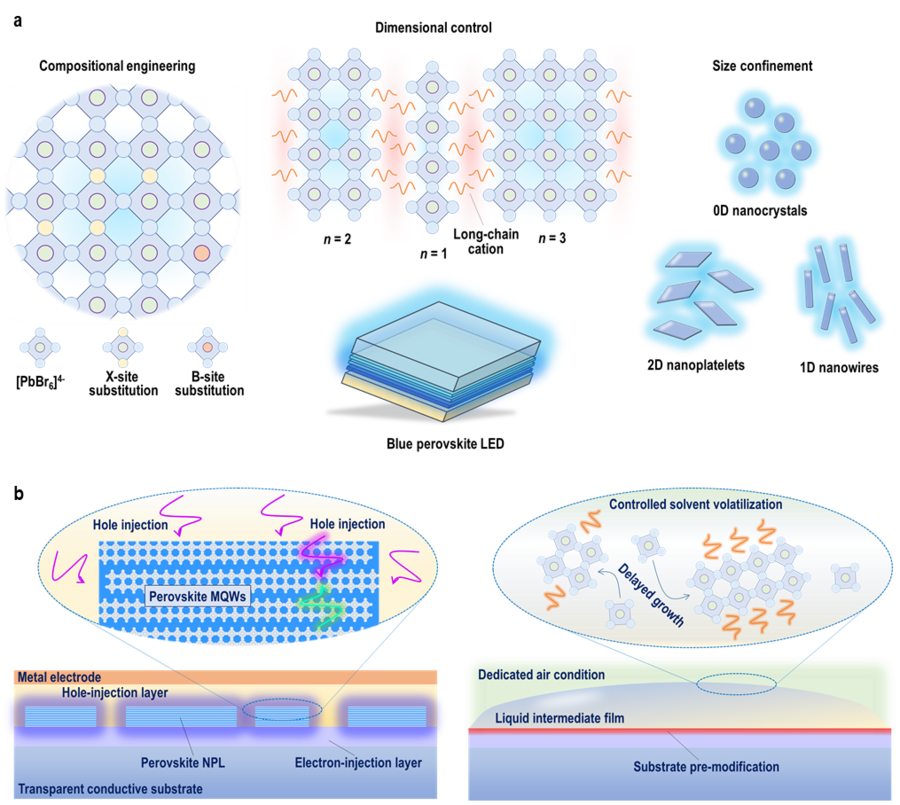Focus on Perovskite Emitters in Blue Light-emitting Diodes
KNOXVILLE, TN, October 17, 2023 /24-7PressRelease/ — Perovskite light-emitting diodes (PeLEDs) are one of the most promising new display technologies, while the performance of their blue devices is a key obstacle to practical applications. Scientists in China comprehensively summarized three main technical routes (compositional engineering, dimensional control, size confinement) towards blue perovskites and the latest progress of blue PeLED. And the future development of blue PeLEDs and prototype structure of high-performance devices are prospected, which provides practical directions for the related fields.
In recent years, the advancement of LEDs based on perovskite materials has progressed significantly. The benefits of perovskite materials, including their straightforward production processes, wide color gamut, high color purity, and low cost, have facilitated the development of efficient red and green PeLED devices, which currently surpass 25% in efficiency. Consequently, PeLEDs have become one of the most promising next-generation display technologies.
However, the successful realization of this new display technology relies on the ability of red, green, and blue (RGB) LEDs to meet the required performance standards. Nonetheless, compared to red and green PeLEDs (R and G), blue PeLEDs (B) have exhibited sluggish progress. The efficiency of blue PeLED devices satisfying display requirements remains a mere 10%, far below that of their red and green counterparts. Furthermore, the stability of blue PeLED devices is insufficient, hindering the practical application of new PeLED technology in the display industry.
In a new paper published in Light Science & Application, a team of scientists, led by Dr. Xiaoyu Yang, Prof. Xinqiang Wang, and Mr. Changjun Lu from Leyard Optoelectronic Co., Ltd, China, School of Physics, Peking University, China, and co-workers have comprehensively summarized three main technical routes (compositional engineering, dimensional control, size confinement) towards blue perovskites and the latest progress of blue PeLED. By employing compositional engineering on perovskites with ABX3 crystal structures, the element or molecular composition, and ratio of A, B, and X sites can be finely tuned. This adjustment results in an effective widening of the bandgap by manipulating the valence and conduction bands in the band structure, thereby enabling blue emission. The quasi-2D, 2D, and 1D crystal structures of perovskites can be attained by substituting small cations at the A-site with larger long-chain cations. By utilizing the quantum confined domain effect, the bandgap of perovskite materials can be effectively widened. In addition, a cascade of energy phenomena arises within low-dimensional perovskite emitting layers featuring mixed n-values. Therefore, controlling the distribution and content of n-values in low-dimensional perovskites is critical. Reducing perovskite materials to the nanoscale (i.e., perovskite nanocrystals) is another promising approach to realizing blue light emission. The surface ligands required for the synthesis of nanocrystals are crucial factors influencing their size, yield, and quality. Therefore, the development and optimization of surface ligands with high adaptability represent a vital technical direction for achieving blue light emission and enhancing device efficiency. In view of the different stability problems caused by three different technical routes of blue perovskites, the author also summarized and elaborated.
“Based on the understanding of the blue perovskites and related PeLED devices, we proposed the future ideal structure of the blue perovskite active layer, blue PeLED device configuration, and the processing methods. We considered that the in-situ growth of low-dimensional perovskite nanoplatelet structures by the Synthesis-on-Substrate method will enhance the probability of carrier radiation recombination and increase the hole injection area, achieving a breakthrough in the efficiency of blue PeLED devices.”
“Blue PeLED devices with pure-blue emission at ~465 nm still lag far behind their green and red counterparts for display applications, and high-quality perovskite blue emitters are believed to be the foremost part that demands more effort on it. We believe that this work will give detailed guidance for the future development of blue perovskite emitters and gives inspiration to the candidate for all-perovskite displays throughout the LED community.” the scientists forecast.
References
DOI
10.1038/s41377-023-01206-2
Original Source URL
https://doi.org/10.1038/s41377-023-01206-2
Funding information
The authors disclose support for the research of this work from Beijing Natural Science Foundation (JQ21005), the National Key R&D Program of China (2021YFB3800100, 2021YFB3800101), China Postdoctoral Science Foundation (2022M720376).
Contact
Xiaoyu Yang
Leyard Optoelectronic Co., Ltd, Beijing, 100091, China.
State Key Laboratory for Artificial Microstructure and Mesoscopic Physics, School of Physics, Peking University, Beijing 100871, China, [email protected]
About Light: Science & Applications
The Light: Science & Applications will primarily publish new research results in cutting-edge and emerging topics in optics and photonics, as well as covering traditional topics in optical engineering. The journal will publish original articles and reviews that are of high quality, high interest and far-reaching consequence.
Chuanlink Innovations, where revolutionary ideas meet their true potential. Our name, rooted in the essence of transmission and connection, reflects our commitment to fostering innovation and facilitating the journey of ideas from inception to realization.
Related Link:
http://chuanlink-innovations.com
—
For the original version of this press release, please visit 24-7PressRelease.com here




